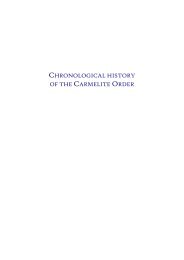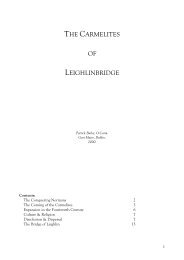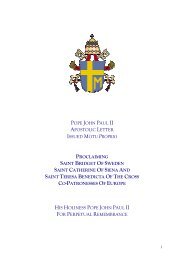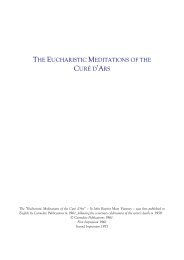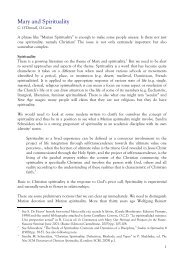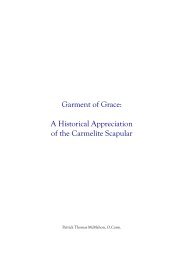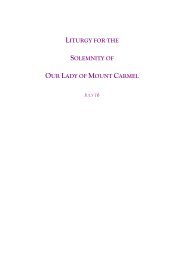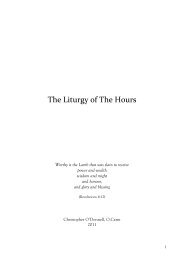The Diocese of Mutare & The Carmelites in Zimbabwe - the Irish ...
The Diocese of Mutare & The Carmelites in Zimbabwe - the Irish ...
The Diocese of Mutare & The Carmelites in Zimbabwe - the Irish ...
Create successful ePaper yourself
Turn your PDF publications into a flip-book with our unique Google optimized e-Paper software.
FOUNDING OF MISSIONS AND PARISHES FROM 1951 TO 1969.<br />
Sa<strong>in</strong>t Anna’s Wengesi (1951)<br />
(Situated around <strong>the</strong> junction <strong>of</strong> <strong>the</strong> <strong>Mutare</strong>/Masv<strong>in</strong>go road and <strong>the</strong> Chimanimani turn-<strong>of</strong>f. About 40Km from<br />
<strong>Mutare</strong>)<br />
Around 1951, Fa<strong>the</strong>r Lamont was donated a plot <strong>of</strong> land to <strong>the</strong> South <strong>of</strong> Umtali. It was a small farm <strong>in</strong> <strong>the</strong><br />
middle <strong>of</strong> a white farm<strong>in</strong>g community.<br />
Fa<strong>the</strong>r Lamont had a house constructed on <strong>the</strong> property and a small school to provide education for <strong>the</strong> local<br />
children <strong>of</strong> <strong>the</strong> farm workers on <strong>the</strong> surround<strong>in</strong>g farms. Fa<strong>the</strong>r John O’Sharkey was appo<strong>in</strong>ted to <strong>the</strong> area. <strong>The</strong><br />
venture proved a dismal failure as <strong>the</strong>re was noth<strong>in</strong>g static about <strong>the</strong> farm workers, <strong>the</strong>y were always on <strong>the</strong> move.<br />
After a short time Fa<strong>the</strong>r O’Sharkey found himself with a school but with few children and <strong>the</strong> whole project was<br />
abandoned.<br />
Sa<strong>in</strong>t Simon Stock, Rusape (1952)<br />
<strong>The</strong> next area to receive attention <strong>of</strong> Fa<strong>the</strong>r Lamont was Rusape Town. Dur<strong>in</strong>g 1952 <strong>the</strong> ‘old Church’, now a<br />
hall was erected (situated beside <strong>the</strong> present Church and Priest’s residence). This was a mistake as it gave <strong>the</strong><br />
wrong impression <strong>in</strong> an area where <strong>the</strong> local people <strong>in</strong> those days outnumbered <strong>the</strong> Europeans by five to one. <strong>The</strong><br />
first Mass was said <strong>in</strong> Rusape dur<strong>in</strong>g 1916. Rusape was an outstation <strong>of</strong> Triashill up to 1958. While at<br />
Triashill, Fa<strong>the</strong>rs M. McMahon and G. O’Brien took turns <strong>in</strong> say<strong>in</strong>g Mass <strong>in</strong> Rusape and <strong>the</strong> services were<br />
conducted <strong>in</strong> English. <strong>The</strong> first Priest took up residence <strong>in</strong> Rusape dur<strong>in</strong>g 1958.<br />
<strong>The</strong>re was a ‘foundation’ <strong>in</strong> Rusape dur<strong>in</strong>g <strong>the</strong> time <strong>of</strong> <strong>the</strong> Trappists. It was situated near <strong>the</strong> railway station and<br />
was known as ‘Sa<strong>in</strong>t Josephs’. It was a fairly sizable cottage and most <strong>of</strong> <strong>the</strong> Trappists and later <strong>the</strong> Mariannhill<br />
brethren spent <strong>the</strong>ir first few days <strong>the</strong>re, hav<strong>in</strong>g arrived by tra<strong>in</strong>. <strong>The</strong> plot <strong>of</strong> ground is still marked ‘<strong>The</strong> Trappist’s<br />
site’ on <strong>the</strong> old survey maps <strong>of</strong> Rusape.<br />
<strong>The</strong> cottage with its small plot <strong>of</strong> ground served as a storage place for goods collected from <strong>the</strong> tra<strong>in</strong> prior to <strong>the</strong>ir<br />
be<strong>in</strong>g taken to <strong>the</strong> missions.<br />
Avila Mission (1953)<br />
To <strong>the</strong> North and East <strong>of</strong> Mount Melleray <strong>the</strong>re were scattered villages <strong>of</strong> Christians or people who were<br />
<strong>in</strong>terested <strong>in</strong> Christianity. Fa<strong>the</strong>r A. Corbett put <strong>the</strong> whole situation <strong>in</strong> perspective when he wrote: “Across <strong>the</strong><br />
mounta<strong>in</strong>s and over towards Mocambique <strong>the</strong>re were scattered villages <strong>of</strong> Chief Nyamaropa’s people who were<br />
still pagan and ra<strong>the</strong>r primitive when compared with those liv<strong>in</strong>g near Umtali. Fur<strong>the</strong>r North <strong>the</strong>re was <strong>the</strong> big<br />
undeveloped area called Nani-Katerere. Mount Melleray was <strong>the</strong> jump<strong>in</strong>g <strong>of</strong>f place for expansion north and<br />
eastwards”.<br />
Dur<strong>in</strong>g 1953 Monsignor Lamont started to organise his new Prefecture. <strong>The</strong> area <strong>of</strong> Katerere was <strong>the</strong> first to<br />
claim his attention. In <strong>the</strong> early twenties, two Trappists Bro<strong>the</strong>rs, Aegidius and Zacharias reached as far as<br />
Katerere from Triashill, a distance <strong>of</strong> over 100 miles. <strong>The</strong> two made such an impression on Chiefs and people<br />
that it was easy for <strong>the</strong> future missionaries to cont<strong>in</strong>ue <strong>in</strong> <strong>the</strong>ir footsteps. When <strong>the</strong> <strong>Carmelites</strong> made <strong>the</strong>ir first<br />
contact with Chief Katerere, he asked <strong>the</strong>m one very search<strong>in</strong>g question ‘was Roma <strong>the</strong> same Church as that <strong>of</strong><br />
Bro<strong>the</strong>rs Aegidius and Zacharias’? When Fa<strong>the</strong>r Corbett told him that it was <strong>the</strong> same church, he gladly and<br />
joyfully gave permission for <strong>the</strong> <strong>Carmelites</strong> to come to his area. Dur<strong>in</strong>g <strong>the</strong> ra<strong>in</strong>y season <strong>of</strong> 1953, Monsignor<br />
Lamont, Fa<strong>the</strong>rs O’Shea and Corbett set out for Katerere which may not have been a good idea because <strong>of</strong> <strong>the</strong><br />
heavy ra<strong>in</strong>s at that time. <strong>The</strong> Monsignor always liked a challenge and liked to impress visitors and probably<br />
wanted to <strong>in</strong>troduce Fa<strong>the</strong>r O’Shea to mission life <strong>in</strong> <strong>the</strong> raw!! <strong>The</strong> three travelled with two local teachers and left<br />
Mount Melleray early <strong>in</strong> <strong>the</strong> morn<strong>in</strong>g <strong>in</strong>tend<strong>in</strong>g to return <strong>the</strong> same day. <strong>The</strong> distance to Katerere was about fifty<br />
21




